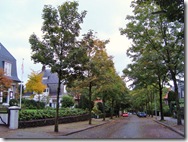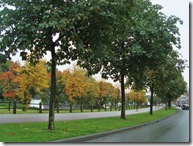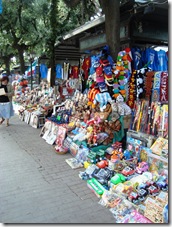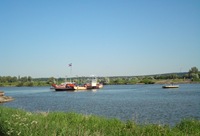 ‘back in town, but a bit scarce while I collate tasks that have accumulated in my absence and try to address the most pressing ones. It was a great trip, but there’s always the return to earth when it’s over.
‘back in town, but a bit scarce while I collate tasks that have accumulated in my absence and try to address the most pressing ones. It was a great trip, but there’s always the return to earth when it’s over.
The weather is deteriorating as fall moves in. Not a good thing: I’ve got to start plans to move to Maastricht and rain, wind, and cold just make that more difficult. The fountains are still bravely running in Sonsbeek Park, so the Dutch haven’t given up on summer.
The news, or course, is dominated by the financial crisis and the failure of the bailout package in the US congress. (The good news, if there is any, is that we’re not talking about Sarah Palin.)
It’s just a mess, isn’t it?
I wrote about this last week, wishing that the government acted more aggressively to dampen speculative booms, to limit government guarantees that promote moral hazard, and to hold irresponsible traders and speculators accountable. Now my bank in the US, WaMu (Yoo Hoo!) has failed, and my bank in the Netherlands, Fortis is teetering. Congress is proposing to shovel money and guarantees into financial institutions, nationalizing the financial markets to an unprecedented degree.
I’ve written my legislators, urging a ‘no’ vote until a rational package can be negotiated, and was happy to see that, in fact, the package did not pass. I cannot understand why the Democrats have wound up on the wrong side of this, voting to bail out the failed Bush policies while the Republicans oppose it. Strange times.
And the underlying causes become ever more clear: There has been a huge game of ‘Pass the Trash’ going on for years, and the chickens have come home to roost.
There has been a chase for yields. People and institutions have been looking for higher returns than they could get in government bonds or bank CDs.
Demand drives supply. Lenders created new interest-bearing obligations by encouraging people and businesses to take on debt. Sometimes the obligations were secured by assets (eg: cars, homes), sometimes not (eg: credit cards, student loans), but at root, it was all about stimulating loans. As volume grew, quality naturally suffered: six years ago the proportion of debt rated 'subprime' was 2%, two years ago it was 33%, a 15-fold increase. It seemed that anything could become a marketable security.
The risks were obscured. These lower-quality obligations carried higher risk, along with higher interest rates. However, like the 'junk bond' funds of the 80's, overall risk could be diminished by grouping low quality bonds into pools, where even if a few borrowers defaulted, the higher interest paid by the rest would still assure a better overall return. Similarly, by dividing principal from interest, near-term from long-term payments, and other criteria, the collections of loans could be sorted and grouped to create pools with almost any variation of risk and return. These newly mixed packages of portions of the original debt became collateralized mortgage obligations (CMO) or debt obligations (CDO). The problem was that nobody trading the securities really understood the equations or the processes behind these new debt packages.
The risks were minimized. Perhaps it was intentional, by brokers, banks, and ratings services, as a way to help move their product. Or maybe it was unintentional: the statistical models weren’t good enough to correlate the overall risk of a “mixture of pieces” back to the actual risks of default in the original loans. In either case, without an accurate assessment of risk, the likelihood of repayment couldn't be known, the risks were foggy, and so the true value of the pools became uncertain.
The returns seemed guaranteed. In the case of mortgages, the true risk was further clouded by implicit government guarantees. In other cases, institutions could purchase insurance (Credit Default Swaps - CDS) from AIG and others to protect against unexpected default. Increasingly, higher returns seemed to come without any perceived risk, completely disconnected from the actual risk and value of the underlying components.
The value became "What the market will pay". The government's commitment to free-market economics meant that there was not agency oversight or regulatory limits on the process, giving free rein to the players and the transactions. As long as there was a greater fool, the value went up with every trade and the traders and speculators skimmed cash from every transaction. Win / win: the holdings were spread, the markets were liquid, the institutions were flush.
Then came the markdown. Last summer, Merrill Lynch needed to raise cash, and was abruptly forced to sell their portfolio of these assets. Although the prices reflected 'fire-sale' circumstances, where they got only 23 cents on the dollar, it was a wakeup call to the financial industry of the true value of these obligations. Even today, the likely value may be as low as 30 or 40 cents on the dollar, even though institutions value them at 50 or 60 cents on their books.
And now, the game has ended. Everyone's being asked to show their hand and call their bluffs, and the fools and losers have become visible to everyone. Lots of them, and some are big ones that should have known better. So now the value of holdings are being marked to a diminished market value, institutions are hoarding their cash against further deflation in value, and most are refusing to trade solid assets or accept questionable ones.
Greed is good? And all of us who ended up chasing yields are coming full circle, to find our loans, pensions, mortgages, and savings tied up in the same mess of contradictions that the banks are suffering.
And so the financial system locked up, and the crisis is upon us. (or so they claim: it still seems like a crisis of perception more than one of fact)
 So what is the right answer now? It’s not to cry wolf, again, and act in haste without understanding. (Jon Stewart had a good side-by-side, line-by-line, montage with President Bush pitching the Iraq plan and pitching the bailout plan. Those who don’t learn are truly condemned to repeat the past.) I’m looking around to see if there is a good summary of the candidates recommendations, but cant’ find them yet.
So what is the right answer now? It’s not to cry wolf, again, and act in haste without understanding. (Jon Stewart had a good side-by-side, line-by-line, montage with President Bush pitching the Iraq plan and pitching the bailout plan. Those who don’t learn are truly condemned to repeat the past.) I’m looking around to see if there is a good summary of the candidates recommendations, but cant’ find them yet.
So, in the absence, I still fall back on my three maxims:
This is not the time to protect institutions (political or financial) from the consequences of their bad behavior: they must be held accountable for their irresponsible (and possibly criminal) actions and decisions.
This is not a time to end our embrace of free markets. But regulations should be put into place to end the ‘pass the trash’ games that has brought us bubble after bubble.
The moral hazard created by government guarantees need to end: the financial industry will always find ways to game the system, and insurance offered will, in the end, be taken. And skimmed.
Okay, well, enough for now. I have a lot of notes and pictures from my travels that I want to talk about, news of life’s next steps to share, and about a dozen blogs with posts to catch up on. ‘back into the neighborhood; collar up and head down against the elements.


Labels: Economics, Idle chit-chat
Bric-a-brac from mid-eastern bazaars are a case in point. In this case, I am able to associate mediocre merchandise with a great story of haggling in the souk, leaving the vendor in tears, bringing home a deal nobody would believe (actually, they shouldn’t, of course). My Jerusalem Ball falls into this category: a faux-silver and gold votive candle in a holder cast to look like the Old City.


![social_network_diagrams2b[1] social_network_diagrams2b[1]](http://lh6.ggpht.com/drhamptn/SOYRC7B469I/AAAAAAAACWc/CCVnw9aZke4/social_network_diagrams2b%5B1%5D_thumb%5B3%5D.gif?imgmax=800)
 cruising fraternity. Blue water sailors talk of their plans to meet friends at favored anchorages, and to form temporary flotillas, a few times each year. Otherwise, they are off as individuals , keeping in touch, but on their own journeys.
cruising fraternity. Blue water sailors talk of their plans to meet friends at favored anchorages, and to form temporary flotillas, a few times each year. Otherwise, they are off as individuals , keeping in touch, but on their own journeys.





